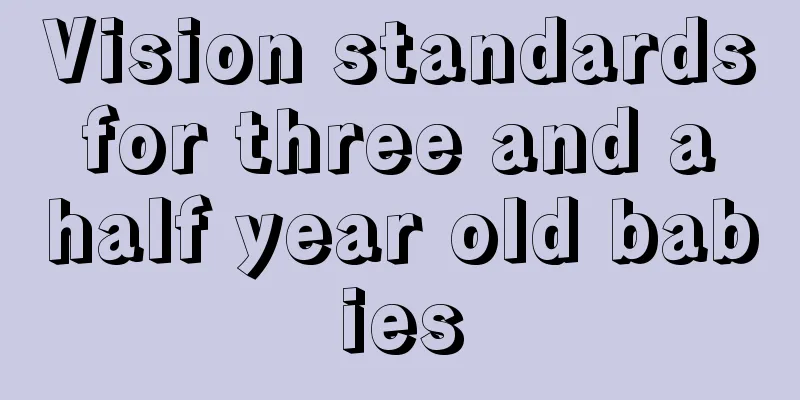Vision standards for three and a half year old babies

|
The vision of a three-year-old baby is relatively high, and they generally do not have congenital eye diseases. The vision of a three-and-a-half-year-old baby is above 5.0, and is close to that of an adult. They can observe objects more clearly, but they are also prone to vision loss, so we should protect our baby's vision. Regarding the baby's vision development indicators, we can learn about the following content. Visual development indicators for babies aged 0-6 Within 1 month: One week after birth, the baby's vision tends to be nearsighted. He can focus on objects 8 to 15 cm away and can follow moving objects with his eyes. After a week, he will be able to see objects up to 3 meters away. He will also learn to track moving objects and like to look at people's faces or high-contrast patterns. When the baby is more than one month old, he can see clearly objects within 15-30 cm in front of him and can focus on objects. 2 months: At 2 months old, the baby's visual concentration becomes more and more obvious. He likes to look at moving objects and familiar adults' faces. Can focus on objects in a coordinated manner and distinguish colors, but cannot distinguish depth. The eyeballs can move with objects within a 90-degree range. When objects approach the eyes quickly, protective reflexes such as blinking will appear, and the child will focus on the hand for more than 5 seconds. 3-4 months: At 3 months, the baby can fix his vision and see objects about 75 cm away, with a visual acuity of about 0.1. The fixation time is significantly prolonged, and the line of sight can follow moving objects. Babies are very sensitive to colors. They have a preference for colors and like to see bright and vivid colors, especially red, and do not like to see dull colors. Their preferred colors are red, yellow, green, orange, blue, etc. When lying on your back, your eyes will track the person who is moving. Walk around in front of your baby often to attract his attention and observe whether his eyes follow you. 5-6 months: The baby blinks more frequently and can accurately see objects in front of him. He will also pick them up and play with them in front of his eyes. When a child sits up to play, he can manipulate objects with his hands under the control of his eyes. He will stare at what he has picked up, and his hands and eyes begin to coordinate. Show the toy in front of the baby and move it slowly up, down, left and right to observe whether the baby can consciously and actively follow it. When the baby is over 6 months old, the eyes can follow moving objects up and down and turn 90 degrees. At this time, the child's vision can reach 0.1, and he can see objects at a longer distance, such as pedestrians and vehicles on the street. 7-8 months: Able to distinguish the distance and space of objects; like to look for toys that suddenly disappear; play "hide and seek" with the baby, and observe the baby's excitement level and whether the reaction is timely. 9-10 months: The baby's eyes can move up, down, left and right following moving objects. The baby can follow falling objects, look for dropped toys, and distinguish the size, shape and speed of movement of objects. Can see small objects and can begin to distinguish simple geometric shapes and observe different shapes of objects. The sense of visual depth begins to appear, which is actually a kind of stereoscopic perception. 11-12 months: The line of sight can move up, down, left and right with moving objects, and can follow falling objects; the visual acuity can reach 0.2 at 1 year old. 1-2 years old: After 1 year old, children like to read books, can distinguish objects, and imitate actions. Under the constant stimulation of external light, the child's vision gradually develops. When he is 1.5 years old, his vision can reach 0.4. He can see small things such as crawling insects and mosquitoes, and can focus on small toys 3 meters away. It can also distinguish simple shapes such as circles, triangles, and squares. 2-5 years old: Binocular vision develops most rapidly. At the age of 2-3, visual acuity reaches about 0.5-0.6, which is almost close to adult vision, but it is very easy to lose vision at this time. At the age of 4 or 5, the visual acuity is about 1.0, and various eye physiological reflexes have been formed and become stable, so it is not easy to lose vision at this time. Children at this stage can judge spatial concepts such as the size of objects, up and down, inside and outside, front and back, and far and near. 6 years old: Enters adult vision at the age of six or seven. The stereoscopic vision function can only reach normal at the age of 9. |
<<: Will double eyelid surgery affect eyesight?
>>: Exercise methods to replenish qi and blood
Recommend
What is endometrial cancer
In our daily life, various types of cancer occur ...
What are the methods for treating lung cancer? Three professional treatment methods for lung cancer
Once patients hear about lung cancer, they will f...
What to eat more to inhibit mold
Mold is a rather annoying fungus because once the...
The most calcium-rich fruit
Children and the elderly are the two groups who n...
How long does it take for rectal medication to be absorbed
Rectal administration is a common method of drug ...
What are the folk remedies for treating lung cancer in life? Try these 3 folk remedies for treating lung cancer
As long as we get sick, our body will be damaged....
How to get rid of mold on clothes
After humid and rainy weather, many people often ...
What are the nursing methods for fibroids
In daily life, fibroids can often be felt by hand...
Excessive sweating is also a warning sign
Some people think that sweating frequently in the...
What is the cause of microangiopathic hemolytic anemia
No matter who you are, you must pay attention to ...
Which hospital has good effect in treating early liver cancer
The treatment of liver cancer is becoming more an...
What to do after one year of taking targeted drugs for advanced breast cancer
What should I do after one year of taking targete...
What is the cause of non-gonococcal urethritis
Non-gonococcal urethritis is often caused by infe...
What should I do if I get tired easily while studying?
Many of my friends feel particularly tired when t...
The difference between eyebrow tattooing and eyebrow embroidery
Misty eyebrows are like those eyebrows that have ...









